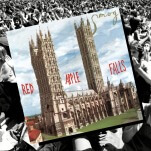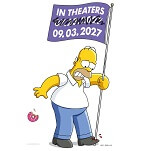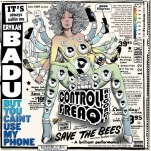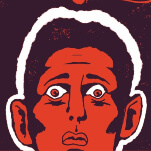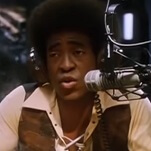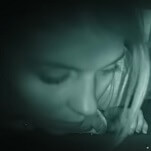New York subway platforms, when all but deserted in the middle of the night, rank high on a list of the world’s creepiest locations. They’re holes underground that seemingly must have been built back when nobody dared leave home without a hat. Huge rats wander openly across the tracks, and sometimes up onto the platform (really), demonstrating not an iota of caution or fear. Often, there’s precisely one other human being standing on the platform at 3:30 a.m., a respectful distance away, striving as hard as you are not to resemble a serial killer on his way home from the random mailbox into which he’s dropped his latest cryptic missive to the cops. And when the train finally arrives, screeching in after perhaps 15 or 20 minutes of unnerving silence, it’s time to suddenly realize how easy it would be for someone to just shove you into its path, and how many big pillars right near you just such a random maniac could have been hiding behind.
Given this sort of ready-made atmosphere, movies shot in New York have pounced on the setting: There are spooky-ass subway-platform scenes in Jacob’s Ladder, Dressed To Kill, and many others. (I regret to say that I haven’t seen Mimic, the Guillermo Del Toro flick in which the Manhattan subway system is infested by giant cockroaches disguised as men in trenchcoats.) Starting in 1998, however, the scene that always crept unbidden into my head when awaiting the L or Q train late at night was the nightmarish vision that Darren Aronofsky dropped into his ultra-low-budget feature debut, Pi. There’s no need for any context here—the movie involves a paranoid number theorist (Sean Gullette) who believes he’s stumbled onto a secret mathematical message, but that’s scarcely relevant to this surreal episode, which perfectly embodies a dread that was hard to articulate until Aronofsky made it manifest.
Maybe most of us don’t sit there pounding our own temples in a vain attempt to make migraines (technically, “cluster headaches”) go away. The first 30 seconds or so of this scene strongly anticipate Aronofsky’s follow-up film, Requiem For A Dream; indeed, the rapid-fire montage that begins this clip—open a pill bottle, shake pills into palm, pop pills into mouth, close pill bottle—resurfaces in Requiem multiple times. And Gullette is being tormented here by Clint Mansell in two different ways. More notably, Mansell composed the aggressively dissonant score (but with a good beat!) that aurally represents the stabbing pain shooting through Gullette’s head. Aronofsky further underlines it with his unstable camera, plus one quick insert of something that looks disturbingly like a deformed eye, but is actually one of Gullette’s ears, half-covered by his hand and with his head tilted 90 degrees. That’s also Mansell playing the One Other Dude on the platform, standing there calmly as blood slowly drips from his right hand.
Because this is a movie, rather than just continuing to sit there, creeped out of his skull and pretending he’s somewhere else, Gullette gets up and runs over to confront the guy. Further emphasizing the remove from reality, Aronofsky shoots most of this by (I assume) attaching the camera to Gullette via some sort of harness, which was a trickier move back in the days before tiny digital-video cameras. (Pi was reportedly shot on a Bolex H-16, which is on the smaller side as film cameras go, but still pretty bulky.) Spike Lee uses a version of this shot as a signature in almost every film, but he invariably has the actor on wheels, appearing to glide; Aronofsky is looking for something more frantic, but still subtly disorienting, so he allows Gullette to jog normally, with the camera matching him step for step in a way that would be impossible for a separate operator to precisely match. It’s one of those amazing tricks cinema can play with our semi-conscious understanding of how movies are shot.
Sharp-eyed New Yorkers will notice that Gullette begins this journey at Rockefeller Center, then somehow takes a magical flight of stairs that deposits him at the 15th St./Prospect Park W. station in Brooklyn—almost certainly a low-budget compromise, but it actually fits well with the scene’s dreamlike nature, as our slumbering brains love to pull that sort of random location shift. And speaking of which—whatever we were expecting that trail of blood to lead to, it wasn’t a disembodied brain (and that really is a human brain, by the way, according to the IMDB), just sitting all chill on one of the steps. Needless to say, Gullette pulls out a ballpoint pen and starts gently prodding the brain, like you do, with each poke producing a sonic hallucination that’s ultimately revealed to be the horn of an oncoming train. (For the record, following the fade to white, he wakes up aboard a train at Coney Island, with blood caked between his nose and his upper lip. Whether any of this actually happened is deliberately left unclear.)
As outré as the imagery itself is, especially in conjunction with Mansell’s throbbing score and Gullette’s intense performance (I love his look of defiant determination each time he prepares to jab the brain again), what makes the scene resonate for me is the way it functions as a metaphor for self-inflicted anxiety. It’s probably not a coincidence, for example, that the blood dripping onto the platform sounds nothing like it actually would in real life, and exactly like water dripping from pipes into puddles, which is what you actually hear late at night in the subway. And when you hear an innocuous sound like that and create a worst-case scenario in your imagination, what are you essentially doing, if not prodding your own psyche? Which is why Gullette’s panicked “What was that?!?” whirls in response to his own impromptu “experiment” play almost as comedy, in spite of the foreboding. What, exactly, did he think was going to happen? Is he aware that test subjects can easily be made to experience phantom visions and sensations via direct stimulus to exposed brain tissue?
Again, I don’t want to generalize too much here, since Pi’s protagonist is something of a whack-job in multiple respects. Still, when viewed in isolation, the scene does contain its own broadly applicable mini-moral: Alone, or nearly alone, in a dilapidated tunnel several feet underground, your brain tends to be your own worst enemy.

